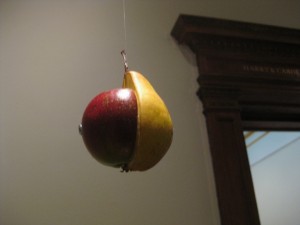These two mismatched halves, screwed together and suspended out of reach, bring to mind both the promise and the pitfalls of romantic love.
First there is the seedy, fruitful aspect of these two fruits pushed together. But then there are the unavoidable differences as they find themselves hung out to dry in a marriage from hell.
Half this story comes from a Greek myth. It is said human beings once existed in pairs, joined back to back, and that jealous god Zeus cleaved them in two “like a sorb-appleâ€. Aristophanes tells the tale in Plato’s Symposium.
The playwright goes on to ask what might happen if, “with all his instruments,†Hephaestus offered to re-attach any two lovers in search of their missing wholeness.
He concludes: “There is not a man of them who when he heard the proposal would deny or would not acknowledge that this meeting and melting into one another, this becoming one instead of two, was the very expression of his ancient need.â€
So no one can resist the invitation of the god of sculpture. This might explain why life is full of odd couples and why we invest so much in a perishable union.
But we might yet say that this symbol of youth (apple) and symbol of immortality (pear) were made for each other. They hang in perfect balance and it is reported that as both halves decay they really do appear to melt into another.
This piece is one of the overseas contributions to Modern British Sculpture at the Royal Academy. It can be seen there, in varying stages of decay, until7 April 2011.
Read more about Swiss artist Urs Fischer from Calvin Tompkins in The New Yorker or from Adrian Searle in the Guardian.
